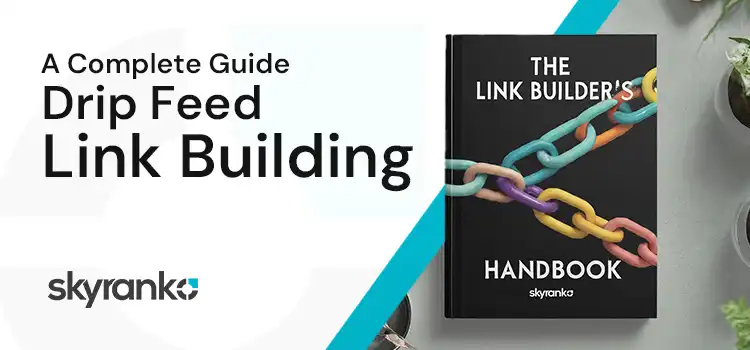Drip feed link building is an effective white hat SEO technique that involves gradually acquiring high-quality backlinks over time. But what makes it different than traditional link-building campaigns?
Unlike mass link-building campaigns, drip-feeding spaces out link acquisition to appear more natural to search engines. Therefore, it’s much safer in nature compared to link-building at scale. Below, you’ll find what are the benefits of the drip-feed strategy, and how to take advantage of it.
What is Drip Feed Link Building?
Drip feed link building refers to the practice of slowly and consistently acquiring backlinks from relevant websites in your industry. The goal is to build quality links over an extended period, rather than obtaining a large volume of links all at once.
This method aims to leverage the power of backlinks for SEO while avoiding the risks of over-optimization penalties. Google favors websites that earn links organically over months and years.
Benefits of Drip Feed Link Building
- Improved search engine rankings – By steadily gaining backlinks from authority sites in your niche, drip feeding can help increase rankings for target keywords.
- Increased referral traffic – Quality backlinks drive referral visitors to your site through clicks on links. This traffic can help grow your audience.
- Enhanced brand visibility – Securing backlinks on industry-relevant websites expands exposure for your brand to new audiences.
- Greater website authority – Slowly building citations from reputable sites signals trust and authority, improving Domain Authority over time.
Is Drip Feed Link Building Safe?
Drip feed link building is generally considered a legitimate and safe white hat SEO tactic when done correctly. The gradual, natural pacing of links avoids risks of manual spam penalties that can come with large-scale, aggressive link-building campaigns.
However, there are still some risks to keep in mind. If your drip feed outreach patterns are too predictable or your link profile shows other suspicious signals, Google could potentially still issue a manual action for unnatural linking. The key is to closely monitor your link velocity, quality, and diversity to ensure your drip feed approach stays within safe guidelines.
How to Set Goals and Develop a Drip Feed Link Building Strategy

Before embarking on a drip feed campaign, clearly define your link building goals and strategy:
Link-building objectives – Consider specific goals like improving rankings for high-value keywords, increasing overall domain authority, or driving more referral traffic from industry websites.
Target linking domains – Research and identify reputable websites and blogs that you can realistically get links from over time. Prioritize sites with high authority scores.
Ideal anchor text – Determine 1-2 primary keyword phrases you want to rank for and build anchor text diversity around them.
Link velocity – Decide on an optimal pace for new link acquisition, such as 5-10 new referring domains per month.
Outreach process – Plan your process for consistent outreach and follow-up to build relationships and earn links.
How to Find Quality Link Placement Opportunities
Finding the right websites and pages to pursue high-quality link placements requires thorough research and analysis. Start by identifying respected industry publications like magazines, journals, and prominent media sites that align closely with your niche.

You can also uncover opportunities by researching relevant, popular blogs with high organic traffic and domain strength. Look for blogs that accept contributed guest posts or may be open to syndicating your content if it offers value to their audience.
Another option is to participate actively in online communities, forums, and groups focused on your industry. Providing value through thoughtful posts and engagement can lead to natural profile link opportunities and mentions.
Use link analysis tools like Ahrefs to uncover websites with overlapping backlink profiles as your competitors. Brainstorm creative ways to add value and build relationships with the webmasters and influencers behind these sites. With rigorous research, you can systematically identify and prioritize the best possible pages to place authoritative, relevant backlinks to your site.
How to Create Valuable Assets to Secure Links
To convince webmasters to link back to your site, focus on developing truly remarkable content assets. Create comprehensive, in-depth guides that provide actionable advice on popular topics in your industry. Conduct and publish original research and surveys with data-driven insights on emerging trends.
Build custom tools, quizzes, and calculators related to your niche that websites will find valuable to link to. Design visually compelling infographics that bring data points to life. Publish annual reports on the state of your industry, with key statistics and takeaways that industry authorities will naturally link to as resources.
How to Implement an Effective Drip Feed Process

When acquiring backlinks, take a slow and steady approach:
- Acquire new links gradually – Aim to earn links from around 5-10 new referring domains each month.
- Vary link types – Build a diverse mix of links like editorial links, profile links, and directory citations.
- Automate scheduling – Use software tools to space out and automate your outreach emails in a drip sequence.
- Diversify placement – Acquire links from different pages on a website and use varying anchor text.
- Monitor new links – Check Google Search Console and analytics regularly to validate new links.
- Disavow toxic links – If any low-quality links slip through, use Google Disavow to protect your site.
How to Avoid Link Over-Optimization
When building links, it’s crucial to avoid overly aggressive tactics that may trigger spam flags. Carefully vary your anchor text, limiting exact match keyword usage and incorporating natural variations like brand name anchors, naked URLs, and partial keyword phrases. Too much replication of exact match anchor text appears manipulative to Google.
Keep your link velocity at a gradual, steady pace over time that mimics natural referral growth, rather than acquiring links too rapidly. Build diversity in your backlink profile by securing links across an array of different high-quality sites, rather than over-relying on the same small group of domains. Monitor metrics like sudden growth spikes that could signal artificial inflation to Google.
How to Track Performance and Results
To determine the success of your drip feed link-building campaign, closely monitor key metrics on an ongoing basis. Track your search engine ranking positions in Google for target keywords related to newly acquired links to see if rankings improve over time.
Keep a close eye on organic traffic coming from search engines using Google Analytics, watching for positive trends. Check referral traffic specifically from new linking domains to confirm they are driving clicks to your site. Monitor your overall domain authority in tools like Moz and Ahrefs to validate that new high-quality backlinks are incrementally increasing your domain authority score.
Review total backlinks and referring domain numbers to ensure you are making steady progress at acquiring new links from additional unique domains. Analyze traffic and conversion metrics as well to see if your new links are impacting business results. By regularly assessing these key metrics, you can determine the ROI of your link-building efforts and optimize your outreach strategy.
Key Takeaways and Recommendations
- Drip feed your link building efforts slowly over an extended period. Gradually earn links from 5-10 new quality sites per month.
- Prioritize securing links from authoritative websites closely aligned with your industry and content focus.
- Create remarkable assets like guides, tools, and original research that websites will naturally want to link to.
- Build genuine relationships with site owners through personalized outreach and active community engagement.
- Monitor analytics and metrics regularly to track the impact of new links and optimize your strategy.
A steady, long-term investment in drip feed link building can yield impressive dividends in increased organic visibility, website traffic, brand awareness, and authority.
FAQs About Drip Feed Link Building
What is the ideal number of links to build per month?
Aim for around 5-10 new quality backlinks from different referring domains each month. Building significantly more than this risks appearing unnatural.
How much time does drip feed link building take?
After the initial research and planning, expect to spend about 5-10 hours per month creating outreach emails, contacting sites, and publishing content.
What’s the best way to get links from authoritative websites?
Creating remarkable assets paired with relationship building through active participation in online communities relevant to those sites.
Is all link-building manipulative? What makes drip feed different?
Aggressive link-building tactics can certainly be manipulative. Drip feed link building earns links slowly in an organic, non-aggressive way that search engines reward.
How long until I see results from drip feed link building?
You should see gradual improvements in rankings, traffic, and authority metrics after about 6 months. But the compounding benefits build over years of sustained effort.
